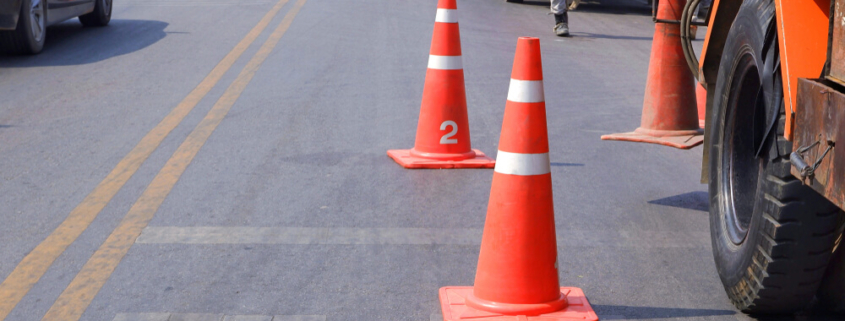Work Zone Awareness – Tips for Traveling Safely in Work Zones
Work zones are temporary traffic control areas meant to transition traffic through a job site where construction, road work, or utility work is in progress. The goal of a work zone is to allow traffic to continue flowing safely through a work area while also keeping workers safe who are trying to complete important work.
As you can imagine, there’s a lot going on in work zones. Heavy equipment combined with moving vehicles, uneven surfaces, overhead dangers, and workers on the ground requires an abundance of caution. Accidents can and do happen.
Common Types of Work Zone Accidents
According to the Federal Highway Administration, work zone fatalities increased by 10.8% between 2020 and 2021 alone. Fatal work zone crashes involving commercial motor vehicles (CMVs) were the highest percentage (33%).
Work zones have several hazards that can lead to higher-than-average accident rates. The most common types of work zone accidents include:
- Collisions with construction vehicles
- Pedestrian accidents
- Sideswipes
- Rear-end accident
- Accidents with cones and barriers
- Heavy equipment accidents
Tips for Traveling Safely in Work Zones
If you work in or near one of these environments, here are some tips for traveling safely in work zones.
1. Know Where the Work Zones Are Located
There are a variety of tools you can use to identify work zones so you know what to expect. A few examples include DOT websites, GPS systems with traffic reporting, and live radio traffic advisories. If possible, avoid these areas completely or go through them during off-peak hours.
2. Be Prepared Emotionally and Physically
If you must travel through or work in a work zone, be emotionally and physically prepared. It’s stressful. You’ll want to be fully rested and pack your patience. Give yourself plenty of time so you don’t add to an already tense situation.
3. Approach Work Zones with Caution
Whether you’re a worker, driver, or pedestrian, approach any work zone with extreme caution. Constantly scan your environment for potential hazards and be ready to take defensive measures. Avoid the temptation to do anything distracting, such as look at your phone.
4. Maintain a Safe Speed
Always take road and weather conditions into account when you are around work zones. Even if the posted speed limit is 10 or 20 mph, the safe limit might be much lower due to the level of activity taking place or the current inclement weather in the area.
5. Stay on the Lookout for Workers and Hazards
Things can happen fast in a work zone. Construction equipment or workers can suddenly end up in a travel lane. Always assume that hazards are present, even at night or on weekends. Also, remain on the lookout for tipped-over cones or tools in the roadway.
6. Watch Out for “Choke Points”
One of the biggest hazards in a work zone is choke points, which is where traffic funnels from several lanes into just one or two. Road rage is common in these areas, as are accidents and injuries.
7. Expect Lanes to Narrow
Most work zone lanes are created to accommodate standard passenger vehicles, so they may not consider the larger size of commercial vehicles. If you’re driving a commercial truck or are a worker standing next to one of the lanes, understand these risks.
8. Carefully Navigate Crossovers
Crossovers are transitions in the roadway where the concrete is even, poorly pitched, or bumpy. Vehicles might be required to navigate these crossovers in a work zone and should do so with caution. Otherwise, load shifts and rollover accidents are possible.
9. Maintain a Safe Following Distance
Rear-end crashes are incredibly common in work zones because drivers aren’t being patient. An extra foot of space won’t make a difference in your arrival time but could prevent an accident and injuries.
10. Pay Attention to Posted Signs
There should be an abundance of posted signage in any work zone that gives multiple warnings of lane shifting and other hazards. Pay close attention to these signs and take them seriously. If the signs are missing, this could be a serious issue that could lead to an accident.
Have You Been Injured in a Work Zone?
Work zones can be chaotic places for workers and drivers alike. While the work crew is doing its best to perform a job, vehicles passing through may not understand the rules or choose not to follow them.
If you’ve been injured in a work zone accident through the course of your work, determining responsibility may be challenging. But every employer must create a safe work environment for their employees. If you’d like to learn more about OSHA’s safety guidelines and your rights after an accident, OSHA Injury Attorney can help.




Leave a Reply
Want to join the discussion?Feel free to contribute!